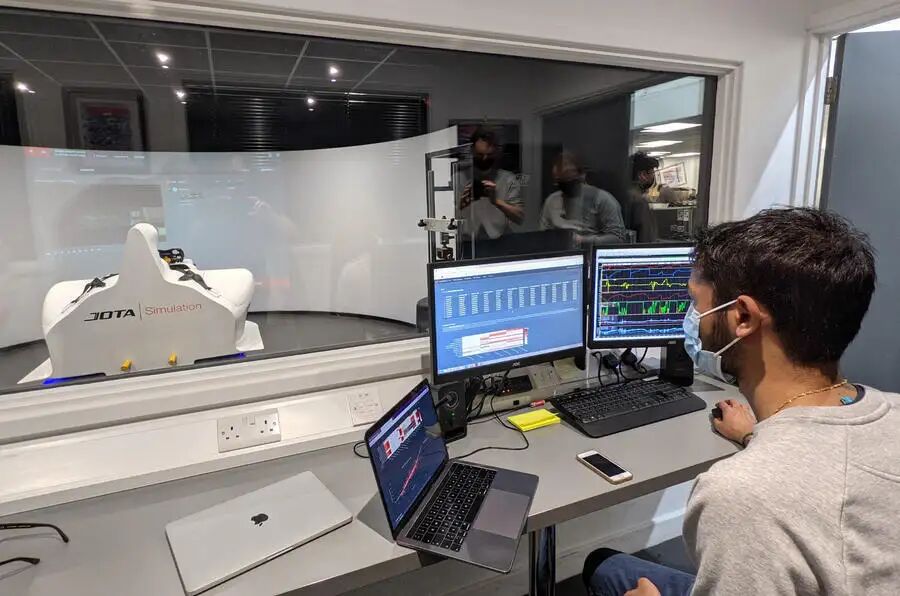Manufacturers large and small stand to gain significantly from virtual testing of components.
It’s said that the average car comprises some 30,000 parts, and today’s machines are irrefutably as complex as ever.
One could argue that electric cars have simpler powertrains, but, from battery chemistries to motor cooling and advanced aerodynamics, the challenges they introduce are more granular and difficult to pin down.
This is where artificial intelligence (AI) comes into play. By modelling tests in excruciating detail numerous times, machine learning can separate variables from the veritable chaos that is a car in motion, where humans would struggle to.
Richard Ahlfeld, CEO of AI firm Monolith, explained: “In my experience, if I give you five data points, you’re going to see a trend and AI algorithms will not. If I give 50 data points, it’s going to be much harder for you, so there’s already a little bit of value in a machine-learning tool. If I give you 1000 data points, you’re going to be completely lost, because you can’t think about 1000 things at the same time, but the machine-learning algorithm is happy.”
BMW partnered with Monolith in 2019 to test whether it could identify the variables that determine whether the tibia (lower leg bone) breaks in a car crash.
Traditionally, this would be nigh-on impossible to identify. “If you take a crash test at BMW, then this is obviously something really complex: there’s thousands of components hitting the wall at 60mph (almost 100km/h),” explained Ahlfeld.
“There are 1100 sensors with really high sampling rates. So it creates something really complex, where stuff is flying around – a huge amount of data. And they keep doing it. A company like BMW does thousands of those tests per year. This creates something complicated [and] really hard to understand – something really hard to model [using traditional statistical methods].”
But by running historic crash test data through Monolith, varying vehicle mass and speed, BMW was able to better understand the tibia – and the point at which it breaks in a crash – without investing in more real-world tests.
Returning to the example of electrification, Ahfeld said: “Experts always love learning something new. They like it when they better understand how long the battery lasts [and] when the battery doesn’t work as they want it to work, so they can improve something.”
But that isn’t to say that the engineer’s input is completely removed. Ahlfeld explained: “[The tech says] here is the data, I’ve visualised to you what I think the important variables are, and I’ve made a prediction for you what is going to happen if you do this. But it’s up to the engineer to actually make the call and say: ‘I want to do this, that makes sense to me’.”
Dennis Clark, managing director of strategic venture partnerships at Honda Innovations, previously told Automotive News: “It’s not about replacing a human being; it’s about supplementing and augmenting their activities, and that’s really where we see, as a company, the value of AI. It almost gives us superpowers.”
It’s not just the depth of understanding that AI can improve but also the speed and cost at which it’s attained.
Monolith claims that its work with Honda – the specifics of which weren’t detailed – resulted in 83 per cent fewer iterations to a part’s final design, compared with traditional engineering methods, saving substantially on time, money and material.
As for BMW, its costs for crash-testing are “cut by up to 80 per cent”, according to a Monolith white paper.
Given that individual crash tests can cost anywhere between £10,000 (AUD$17,000) and £1 million (AUD$1.7,) according to a research paper from the 15th ISPE International Conference on Concurrent Engineering, the use of AI offers significant cost and time savings to the development of a new car.
As the scope of a project is reduced, the benefits offered by AI can grow significantly.
Since racing team Jota Motorsport began its partnership with Monolith, it has cut costs related to entering the Le Mans 24 Hours by 66 per cent. It has also halved the time required to set its car up for each event, plus the number of simulations required, owing to the increased accuracy of each simulation as its database grows.
And the ease with which data can now be gathered means that applying AI isn’t strictly limited to big or historic firms with large data banks.
Discussing Monolith’s partnership with British start-up Ox Delivers, maker of the Gordon Murray-conceived Ox Truck, Ahlfeld explained: “If you look at the way data is distributed, 30 years ago there was very little but now it’s [growing exponentially]. Lots of new data is coming into the pipeline every day.
“And so the way new companies [operate] is by collecting a lot of information. They will run many more simulations; they will [use] lots more sensors on their test equipment.
“So when we’re looking at those new companies like Ox Truck, they will say: ‘We already have a really early stage prototype where we’re getting data on how long the battery lasts and our performance; can we use that immediately to do analytics to improve the battery performance?”
Start-ups can also take advantage of shared data libraries. For example, Nasa, one of Ahlfeld’s previous employers, donates wind-tunnel data. The National Composite Centre has also donated data from 5000 tests of carbonfibre’s properties, while Kistler has contributed vehicle-dynamics data to help companies model material fatigue over time.
“We’re trying to build a bit of a benchmark library,” noted Ahlfeld. “But it’s definitely a bit of a slow process, because it can’t just have 100,000 [contributors]. I wish I did.”
Charlie Martin




